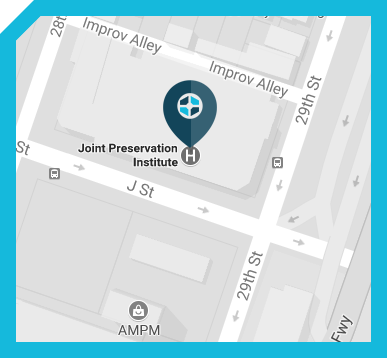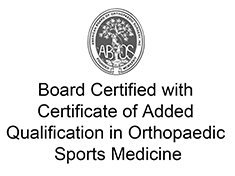 Knee Pain
Knee Pain

The knee is one of the largest joints in the body, formed by the lower end of the femur, upper end of the tibia and the patella or knee cap. Several ligaments and muscles attach to the bones of the knee joint to maintain normal motion of the joint. Special cartilaginous tissues known as menisci are placed between the two articular ends of the joint. These act as a cushion between the articular surfaces and absorb the shock during movement.
Knee pain is a common condition affecting individuals from different age groups. It not only affects movement but also impacts the quality of life of the individual. An injury or disease of the knee joint or any structure surrounding the knee can result in knee pain. A precise diagnosis of the underlying cause is important to develop an appropriate treatment plan.
Some of the common causes for knee pain include:
- Arthritis: a condition associated with inflammation of the joint
- Knee ligament injuries
- Torn meniscus
- Patellar tendonitis: inflammation of the patellar tendon which connects the kneecap to the shin bone
- Chondromalacia patellae: softening of the articular cartilage on the under surface of the kneecap causing knee pain
- Dislocated kneecap
- Baker's cyst: a fluid-filled swelling in the back of the knee which usually results from another problem such as a meniscus tear
- Knee bursitis: inflammation of the bursae, small fluid-filled sacs located around the joints, usually between a tendon and the bone.
- Plica syndrome: results from inflammation of the synovial tissue of the knee causing knee pain and swelling.
- Osgood-Schlatter disease: caused by irritation of the growth plate at the front of the knee joint and is more common in adolescents
- Osteochondritis dissecans: characterized by detachment of a cartilage fragment and a thin layer of the bone from the end of a bone due to inadequate blood supply; these fragments may either stay in place or slide around the joint causing pain and joint instability
- Gout: characterized by sudden, severe attacks of joint pain, with swelling and redness around the joint, caused by accumulation of uric acid crystals in the joints
Diagnosis
Knee conditions should be evaluated by your doctor for a proper diagnosis and treatment. A detailed medical history and physical examination of the knee are crucial for the diagnosis. Your doctor may also conduct diagnostic imaging studies such as X-rays, MRI scans, CT scans, and ultrasound. Blood tests may be performed to identify any infection, gout or pseudogout. Sometimes arthrocentesis may also be performed, wherein the fluid from the knee joint is removed and sent for laboratory analysis.
Treatment
Treatment options depend upon the underlying cause responsible for knee pain. Some of the common treatment options for knee pain include rest, ice and heat application, non-steroidal anti-inflammatory medications, stretching, physical therapy and cortisone injections.
Sometimes a knee arthroscopy may be performed. Knee arthroscopy is a surgical procedure in which the internal structures of the joint are examined to diagnose as well as treat the underlying problem.
If you have trouble or inability to walk, deformity around the joint, inability to bend the knee, knee pain persisting beyond a few days and more at night, or pain associated with swelling, warmth, or redness, you should consult your doctor for immediate medical intervention.
Anterior Knee Pain
Anterior knee pain is a characterized by a chronic pain over the front and center of the knee joint. It is common in athletes, active adolescents (especially girls) and overweight individuals. Anterior knee pain refers to a variety of conditions which include runner's knee or patellar tendinitis and chondromalacia of the patella. There is an inter-individual variation in the duration and presentation of pain.
The knee joint is a large, complex joint in the body comprising of three bones, i.e. the lower end of the thigh bone or femur, upper end of the shinbone or tibia, and the kneecap or patella. The patella moves over the joint and allows bending of the knee and straightening of the leg. There are a few major ligaments situated around the knee joint which hold the joint firmly in position and contribute to the stability of the knee.
Causes
Anterior knee pain usually develops due to improper movement of the knee cap causing it to rub against the lower end of the femur bone. This may occur secondary to an imbalance or poor flexibility of the thigh muscles that stabilize the knee joint, problems with alignment of the knee joint, flat foot, tightness or weakness of the front and back muscles of the thigh, excessive sports activities, improper sports training techniques or improper use of equipment. Other possible causes for anterior knee pain include arthritis, cartilage injury and dislocation or fracture of the patella or knee cap.
Symptoms
Pain is the predominant symptom and is usually gradual in onset. Patients may experience a dull aching pain around the sides, below or behind the knee cap. Sometimes, climbing stairs and standing up or walking after prolonged sitting may produce a popping or cracking sound in the knee. The pain may also be present at night and be exaggerated by any repetitive knee bending activity such as jumping, squatting, running or weight lifting. Any changes in the activity level, playing surface or equipment may also result in pain.
Diagnosis
Diagnosis of anterior knee pain includes a medical history and physical examination along with imaging tests such as X-ray and MRI scan. Physical examination determines the cause of pain and other related problems while X-rays and MRI scan aid in confirming the condition by providing visualization of the internal structures.
Treatment
Most patients respond to conservative treatment which includes application of ice, rest and well programmed rehabilitation exercises. Ice helps to relieve the swelling and inflammation, rest protects the joint from repetitive injury while stretching and mobilization exercises improve muscle strength, flexibility and range of motion. Sometimes, if needed, pain relieving medication and anti-inflammatory drugs may also be used. Surgical treatment is rarely indicated.
Prevention
Chronic persistent pain needs to be reported to the doctor immediately. Once the pain has been treated, a recurrence can be prevented by following a few simple measures which include:
- Wearing appropriate shoes for your sporting activities
- Performing warm up exercises before any physical activity
- Discontinue any activity causing pain in your knees
- Modulating the intensity of activity depending on your condition












